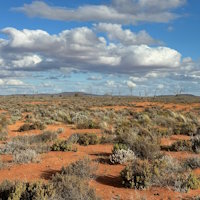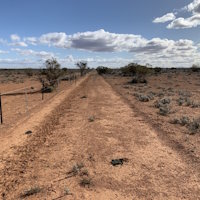Frome Project
Overview
The Frome project comprises four exploration licences EL 6554 (Frome Downs), EL 6555 (Curnamona), EL 6703 (Erudina) and EL 6900 (Billeroo) covering a combined area of 3,037 square kilometres, located in the Frome Embayment of South Australia. The Frome Embayment area is arguably the most prospective region in Australia for sandstone-hosted uranium deposits.
The Frome project is located approximately 12 km west of the Goulds Dam Uranium Deposit held by Boss Energy Ltd (ASX: BOE) who recently announced two new satellite prospects adjacent to Goulds Dam (Billeroo and Sunrise).
Prospectivity
The Frome project is highly prospective for sedimentary and structurally-hosted uranium mineralisation as sandstone hosted basal sands, roll-front and tabular deposits hosted within Tertiary palaeochannels, similar to the nearby Beverley, Four Mile and Honeymoon Uranium Mines and Goulds Dam, Jasons, Saffron and Oban Uranium Deposits, (Figure 1).
The Frome project covers sandstone-bearing palaeochannels that contain groundwater that drains from uranium-bearing granites of the Crocker Well Granite Suite, (Figure 1). Tertiary stratigraphic units that host uranium mineralisation regionally includes the highly prospective Eocene Eyre Formation where economic uranium mineralisation has been encountered in sands of the Eyre Formation at Four Mile, Honeymoon, Goulds Dam and Oban; and the prospective Miocene Namba Formation where economic uranium mineralisation has been encountered in sands of the Namba Formation at Beverley.
At the Erudina prospect, work by Orpheus has inferred 12 kilometres of redox front within palaeochannels along which high priority exploration is necessary. Previous drilling of these palaeochannels confirms the presence of excellent sandstone aquifers at or near the base of the channels. These sandstone aquifers are 4m to 20m thick (typically 10-12m) and contain the necessary permeable coarse sands. These basal sandstones have been shown to contain both oxidised, uranium-bearing zones and reduced zones.
Geology
The Frome project is situated in the south-western region of the Frome Embayment, bound to the west by Neoproterozoic sediments of the Adelaide Geosyncline, bound to the east by the Mesoproterozoic Benagerie Ridge and bound to the south by the Palaeoproterozoic Willyama Supergroup of the Olary Ranges. The region comprises significant basin sedimentation of Proterozoic Adelaidean sediments, overlain by Cambrian sediments within the Moorowie Sub-basin and is unconformably overlain by Tertiary sediments of the Callabonna Sub-basin. Basement lithologies are inferred to comprise Palaeoproterozoic Willyama Supergroup, Mesoproterozoic granite intrusives of the Ninnerie Supersuite (1,696 to 1,580 Ma), including the Crocker Well Suite granite (1,579+2 Ma) and volcanics of the Benagerie Ridge Volcanics (1,582+4 Ma).
The Frome project hosts a number of inferred palaeochannels previously interpreted from regional electromagnetic surveys and drilling data, to include: Curnamona Palaeochannel, Billeroo Palaeochannel, Erudina Palaeochannel (north and south), Frome Downs Palaeochannel, Stickhole Palaeochannel and Wyambana Palaeochannel.
At the Frome project there are the following key geological units:
- The Eocene Eyre Formation and the Miocene Namba Formation;
- The underlying Arrowie Basin, which includes the hydrocarbon-bearing Wilkawillina Limestone;
- The Crocker Well Suite granite which is an excellent uranium source rock and displays a strong radiometric anomaly where it outcrops; and
- Faults that cut both the Arrowie Basin sediments and the overlying Eyre and Namba Formations.
Uranium rich source rocks, a permeable sandstone aquifer to carry the oxidised, uranium bearing groundwater, and the introduction of a reductant along faults from a lower, hydrocarbon-bearing aquifer are all key technical characteristics required in this geological environment for potential economic uranium deposits.

Figure 1: Frome project ELs with interpreted Eyre Formation palaeochannels, extending north from proposed uranium source rocks of the Crocker Granite Suite
Exploration
Exploration activities proposed by Orpheus include programs designed to test existing targets at the Erudina prospect and define the concealed palaeochannel drainage systems and regional structures in detail for target delineation. The Frome project landscape is shown (Photo 1).
Exploration methods likely to be employed include airborne geophysics (including EM), detailed ground geophysical surveys such as ground gravity, passive seismic to define concealed palaeochannel features followed by drilling (Rotary Mud, Aircore, Diamond and/or Sonic) and downhole geophysical logging. In the event of a Mineral Resource, mining methods applicable to sedimentary hosted uranium deposits include In-Situ Leach methods (ISR), as used at the nearby Beverley, Four Mile and Honeymoon Uranium Mines.

Photo 1: Frome project landscape (photo taken September 2023)

URANIUM PROJECTS
South Australia
South Australia
Northern Territory
South Australia
South Australia
South Australia
South Australia
Australia & Zambia
South Australia and NT








